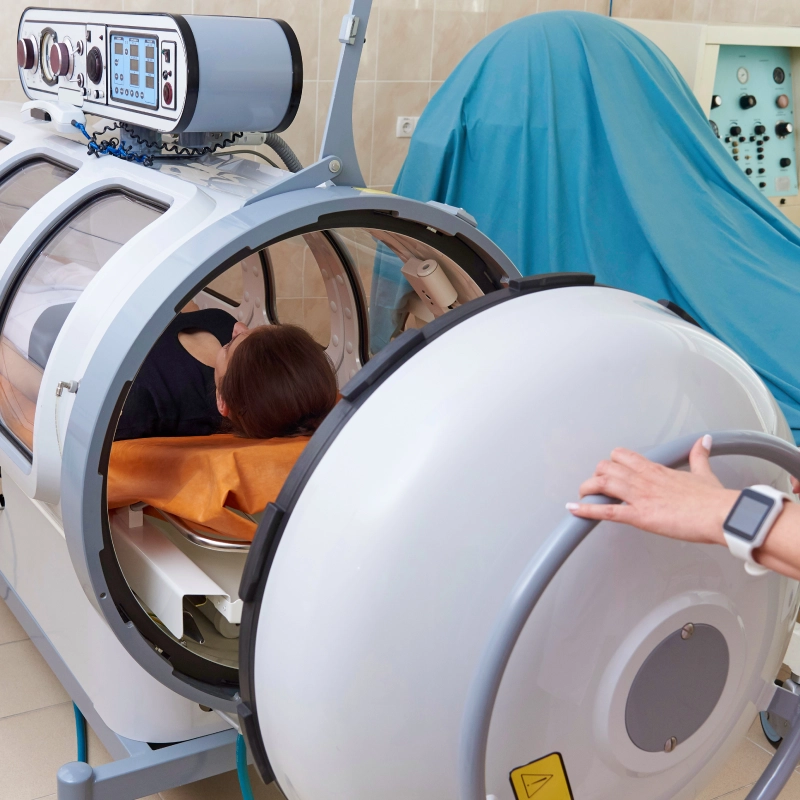
The human brain, the most complex organ in our body, thrives on oxygen. It consumes a disproportionate amount of oxygen compared to its size, highlighting its critical role in neurological function. When this vital supply is disrupted, as in various neurological conditions, the brain's ability to heal and function optimally can be compromised. Hyperbaric Oxygen Therapy (HBOT) emerges as a potential ray of hope, offering a non-invasive approach to enhance oxygen delivery and promote neurological healing.
What is Hyperbaric Oxygen Therapy (HBOT)?
HBOT is a medical treatment that involves administering 100% concentrated oxygen in a pressurized chamber. The increased pressure allows more oxygen to dissolve into the blood plasma, significantly exceeding the amount carried by red blood cells alone. This creates a reservoir of oxygen-rich blood, which can then deliver oxygen more effectively throughout the body, including the brain.
HBOT and Neurological Benefits
The potential of HBOT in neurological healing is a growing area of research. Here's a glimpse into how HBOT might benefit various neurological conditions:
- Brain Injury: Traumatic Brain Injuries (TBI) can cause swelling, inflammation, and reduced blood flow to the brain. HBOT is believed to reduce inflammation, promote blood vessel growth (angiogenesis), and stimulate the production of growth factors that aid healing. Studies suggest improved cognitive function, memory, and motor skills in TBI patients receiving HBOT [1].
- Stroke: Strokes occur when blood flow to a part of the brain is blocked. The oxygen deprivation can lead to cell death and functional impairment. HBOT may help by reducing swelling, improving blood flow, and promoting the growth of new blood vessels in the damaged area. This can potentially limit tissue damage and enhance recovery [2].
- Degenerative Diseases: Conditions like Alzheimer's and Parkinson's disease are characterized by progressive neuronal loss and impaired blood flow. HBOT's ability to increase oxygen delivery and stimulate the growth of new blood vessels might offer neuroprotective benefits, slowing disease progression and potentially improving symptoms [3].
- Autism Spectrum Disorder (ASD): Research on HBOT and ASD is ongoing. Some studies suggest improvements in social interaction, communication, and repetitive behaviors in children with ASD who underwent HBOT [4]. However, more robust research is needed to confirm these findings.
How Can HBOT Benefit Neurological Healing?
The potential benefits of HBOT for neurological conditions stem from its ability to increase oxygen delivery to the brain. Here's a closer look at how HBOT might promote healing:
- Reduced Inflammation: Inflammation is a common thread in many neurological disorders. HBOT's anti-inflammatory properties can help reduce swelling and create a more favorable environment for healing.
- Improved Blood Flow: Increased oxygen levels can stimulate the growth of new blood vessels, promoting better blood flow to the brain. This is especially crucial in areas affected by stroke or injury.
- Stem Cell Activation: Studies suggest HBOT can activate stem cells, the body's natural repair system. These stem cells can potentially migrate to damaged areas of the brain and promote regeneration.
- Neuroplasticity Enhancement: Neuroplasticity refers to the brain's ability to learn and adapt. HBOT may enhance this process, allowing the brain to reorganize itself and form new connections after injury or disease.
- Increased Oxygen Delivery: The elevated pressure in the chamber allows more oxygen to dissolve in the blood plasma, bypassing the need for red blood cells to carry all the oxygen. This ensures a higher oxygen concentration reaches tissues with compromised blood flow.
Is HBOT Right for You?
HBOT is an adjunct therapy along with other neuro-rehabilitation procedures. But it's not a one-size-fits-all solution. Consulting a healthcare professional is crucial to determine if HBOT is appropriate for your specific condition. Here are some factors to consider:
- The underlying neurological condition
- The severity of the condition
- Overall health status
- Potential risks and side effects of HBOT
HBOT: Safety Considerations
While generally safe, HBOT can have some side effects like ear pain, sinus congestion, and temporary vision changes. It's essential to undergo a thorough evaluation before starting therapy to ensure you're a suitable candidate.
The Future of HBOT
Research on HBOT and its applications in neurological healing is constantly evolving. Larger, well-designed clinical trials are needed to solidify the evidence base and define treatment protocols for various neurological conditions. However, the initial findings are encouraging, suggesting HBOT has the potential to become a valuable tool in the neurological rehabilitation toolbox.
Conclusion
Hyperbaric Oxygen Therapy offers an alternate avenue for promoting neurological healing. By enhancing oxygen delivery and stimulating regenerative processes, HBOT might benefit various neurological conditions. If you're struggling with a neurological issue, discuss HBOT with your doctor to see if it could be a potential part of your treatment plan. Remember, HBOT is not a standalone therapy, and it's crucial to follow your doctor's comprehensive treatment recommendations.

